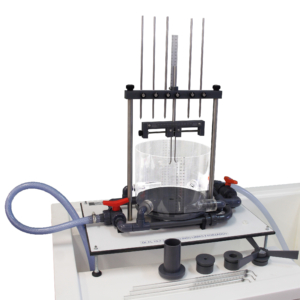FL 17.2 – Losses in Pipes
The objective to be achieved with this equipment is the study of the primary losses of load that occur along a pipe, in two regimenes: laminar and turbulent.
Description
This equipment counts on a vertical pipe, in which we make the readings of the loss of load produced for different flows; Flow rates that we obtain through the regulating valve with which the equipment counts.
The study of the different regimes is achieved by modifying the way in which the water reaches the test pipe, so that, in order to achieve the laminar regime, the pipe is fed from a tank of constant height while for the turbulent regime the supply will be made directly from the water supply equipment.
For the readings of upstream and downstream pressures of the test line, we have two differential pressure gauges, one of water and one of mercury.
Measurements of the flow rates obtained with the control valve are performed using the supplied test tube or the volumetric reservoir of the hydraulic bank (required), which also studies the relationship between the pressure drop and the fluid velocity.
Learning Objectives
The practices and experiences that can be realized with this equipment are the following:
- Determination of the primary losses of load produced in a pipe in laminar regime.
- Determination of the primary losses of load produced in a pipe in turbulent regime.
Technical Data
Inner diameters:
- Test pipe Æinterior = 3 mm. ; Æexterior = 4 mm.
Manometric intakes:
- Distance between two manometric intakes 500 mm.
Manometers:
- Water column manometer, measurement range 500 mm c.a.
- Manometer of Hg , measurement range 500 mm c.a.
Test tube:
- Capacity of 1000 ml
Requirements
- Hydraulic bench FL 01.4









